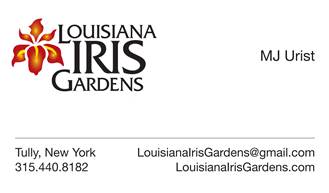Culture information provided below is the result of trial and error and best guess practices derived from assimilating the mass of instructions geared toward Southern growing, and applying years of practical Northern gardening experience.
Selecting and preparing your site
Begin by locating a very sunny spot in your yard, unobstructed by trees or buildings. When grown in the south, Louisiana iris will tolerate a sun to partial shade location. In our area, however, FULL sun is critical. While the iris may grow and multiply in less than optimal locations, bloom will be severely impacted.
There is a common misconception that Louisiana Irises are a water plant. While they will grow happily in a backyard pond or water feature, they are equally adaptable to a range of garden soils. A location that either tends to remain moist throughout the growing season, or is convenient to a watering source will work just fine.
Louisiana irises are also tolerant of a range of soil pH, though traditional wisdom touts the acid soil (around 6.5) as the gold standard for optimal growth. In most cases adding compost and other organic rich material materials to the planting site will stabilize your soil pH and encourage a healthy soil structure at the same time. Two to three inches worked into the planting site prior to planting can be very beneficial.
An application of a balanced fertilizer, such as 8-8-8 at a rate of eight to ten pounds per 100 square feet during bed preparation will give your plants a leg up as they take hold. If your soil is especially alkaline, you may wish instead to use an acidifying formulation, such as those marketed for use on azaleas and rhododendrons.
Time to plant!
Most growers ship in August and September, which just happens to coincide with the best time to plant. All rhizomes will benefit from an overnight soak, even if you’ve just divided your own clump, but especially if they’ve been out of the ground for any length of time during shipping.
Open up a nice piece of ground and settle the rhizome so that it will be covered with a half inch to inch of soil after planting. Unlike bearded irises, Louisiana rhizomes do best when they remain covered, although the will tend to come to the surface over time. Spread any fibrous roots out into the hole, and fill in around them. Most of these roots will slough off and be replaced over the next weeks, but give the plants a chance to draw up any moisture they can before losing them.
Once in the ground, water heavily and keep well watered until the plants are established. A two or three inch layer of light mulch will aid in both moisture retention and weed suppression. We use (and highly recommend) long needle pine straw. It is not only a great insulator in the winter, but also prevents many weed seeds from reaching the soil and is less hospitable to slugs and snails. You may have to do some research to find suppliers, but it is available. Composted leaves and pine bark are alternatives, but avoid large nuggets or recycled product mulches.
Just a note about planting near ponds or water features: set your rhizomes just above the high water mark, and point the growing tip toward the water. The iris will establish itself at the correct depth. Water culture irises in our climate sometimes have trouble if they lose their leaves over winter and are submerged for a prolonged period of time.
Time to fertilize (again)!
I can’t stress enough the importance of fertilizing for optimum bloom and growth. Anecdotally, I have not heard of many fully satisfactory growing experiences employing organic growing methods. In fact, if there is anyplace that most home gardeners fall short in Louisiana iris culture, it is failing to supply adequate fertilizer. The application schedule I follow is a modification of that used in the deep South, and it has been very successful over the last several years. Shortly after the plants come out of winter dormancy in late April or early May (about six to eight weeks before bloom season), I apply a bloom boosting low nitrogen fertilizer (0-20-20 or 5-20-20). This provides that added punch the irises need to get their bloom stalks up quickly.
Since Louisiana irises in our area will continue to grow through the summer and well into the fall, they benefit from an application of a balanced formulation (8-8-8, 10-10-10, or 12-12-12) after they are finished blooming. Plan to do this late in July.
Louisiana iris grower maxim: YOU CAN NEVER OVER FERTILIZE A LOUISIANA IRIS.
Water requirements
As garden plants go, Louisiana iris prefer their beds on the well-watered side, but their tolerance to some variation in soil moisture is one of the things that also makes them a good rain garden inhabitant. Rule of thumb is to make sure your irises don’t dry out completely during the growing season and water generously from spring till bloom if the weather is uncooperative.
Dividing your clumps
Expect that in three or four years your iris plantings will have increased to the point that bloom may be reduced and the clump will have migrated into areas away from where you want them. It’s a good idea to lift the entire clump, separate the rhizomes, wash and inspect them for signs of insect damage or disease. Before replanting, add some more organic material to the planting site. Space the rhizomes back out to about a foot apart. Give some to your friends!

|


